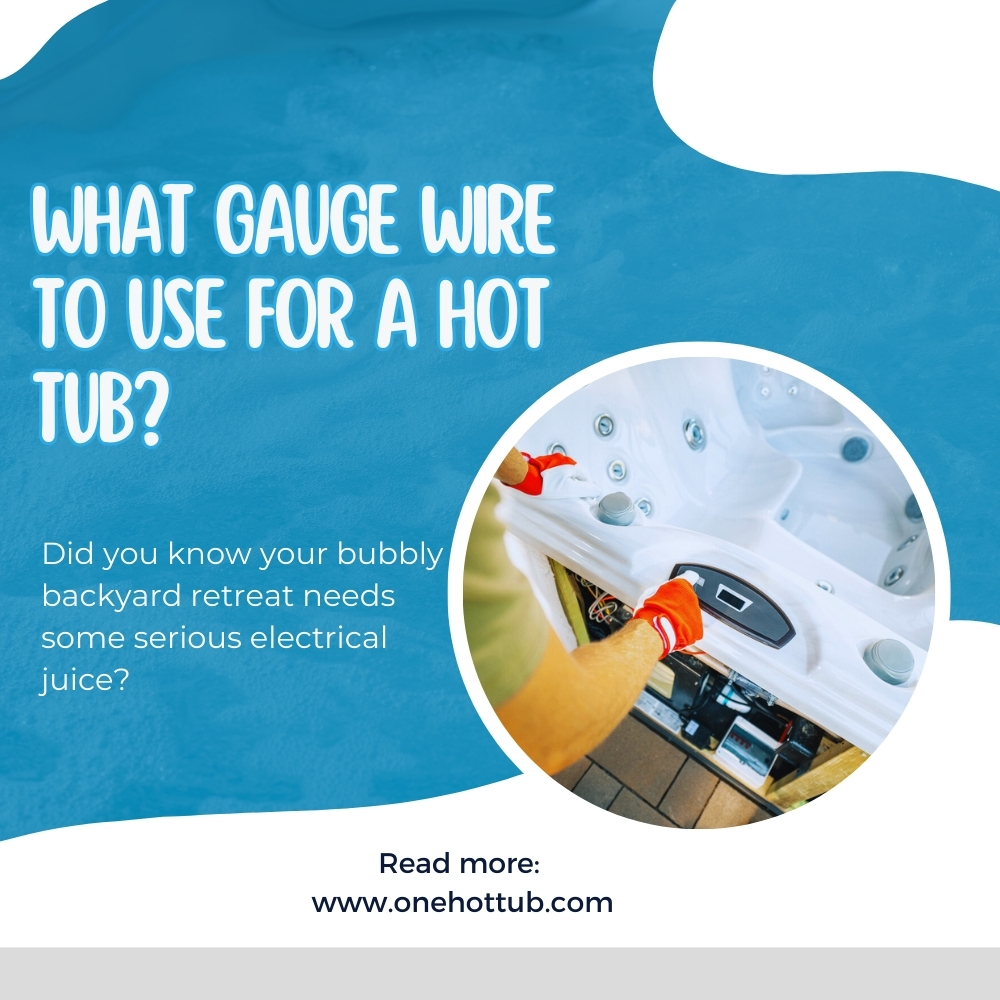Table of Contents - What Gauge Wire To Use For A Hot Tub?
- Hot Tub Wiring Made Simple
- Understanding Hot Tub Electrical Requirements
- Understanding Hot Tub Electrical Requirements
- Selecting the Correct Wire Gage for Hot Tub Installation
- Wire Gage Basics: What the Numbers Mean
- 50-Amp Hot Tub Wire Size Requirements
- How Distance Affects Wire Gage Selection
- Copper vs. Aluminum Wire for Hot Tubs
- Essential Materials for Hot Tub Wiring Projects
- Essential Materials for Hot Tub Wiring Projects
- Step-by-Step Hot Tub Wiring Installation Guide
- Planning Your Wiring Route
- Installing the Electrical Panel Connection
- Running Wire Through Conduit
- Making Final Connections to the Hot Tub
- Common Hot Tub Wiring Mistakes and How to Avoid Them
- Final Thoughts
- FAQs
This blog post may contain affiliate links. As an Amazon Associate I earn from qualifying purchases.
What Gauge Wire To Use For A Hot Tub?
Hot Tub Wiring Made Simple
Understanding Hot Tub Electrical Requirements
Understanding Hot Tub Electrical Requirements
Basic Voltage and Amperage Needs for Hot Tubs
- Heating elements that keep your water toasty
- Circulation pumps for crystal clear water
- Jets and blowers for that massage magic
- Lighting and control systems for the perfect ambiance
Difference Between 120V and 240V Hot Tub Systems
| 120V “Plug-and-Play” Systems | 240V Hardwired Systems |
|---|---|
| Just plug into standard outlets | Need professional installation |
| Use 1,500-3,000 watts | Pack a bigger punch with 3,000-6,000 watts |
| Heat up slower | Heat water faster (2-5° per hour) |
| Can’t run heater and high-speed jets together | Run everything at once – party time! |
| Best for smaller tubs with fewer bells and whistles | Perfect for larger tubs with all the fancy features |
| No extra installation costs | Require an electrician and dedicated circuit |
Identifying Your Hot Tub’s Power Specifications
- Grab your owner’s manual – it’s a goldmine of details
- Look for these electrical must-knows:
- Required voltage (120V or 240V)
- Amperage requirements (usually 40-60 amps for 240V systems)
- Wire size recommendations (super important!)
- GFCI protection details
Selecting the Correct Wire Gage for Hot Tub Installation
Wire Gage Basics: What the Numbers Mean
50-Amp Hot Tub Wire Size Requirements
- Your circuit type and breaker size (the electrical gatekeepers)
- How far your wire needs to travel (the marathon factor)
- What your hot tub maker says (they wrote the rulebook)
- Your local electrical codes (your area might have special rules)
| Hot Tub Amperage | Recommended Wire Gage |
|---|---|
| 30 Amp Hot Tubs | 10 AWG or 12 AWG |
| 40 Amp Hot Tubs | 8 AWG or 10 AWG |
| 50 Amp Hot Tubs | 6 AWG or 8 AWG |
| 60 Amp Hot Tubs | 6 AWG |
How Distance Affects Wire Gage Selection
- Your hot tub components get starved of power (like an engine running on fumes)
- Motors and heaters strain harder (shortening their lifespan)
- Components can fail early (goodbye, relaxing bubbles!)
- Breakers trip when you least expect it (usually when you have friends over)
Copper vs. Aluminum Wire for Hot Tubs
Wire Type
- Copper Wire
- Aluminum Wire
Pros
- Better conductivityCorrosion resistantMore flexibleIndustry standard
- Lower cost
Do’s and Don’ts of Hot Tub Wire Selection
Do’s
- Use copper stranded wire
- Match wire size to manufacturer specifications
- Consider increasing wire gage for long runs
- Use THHN-stranded insulation for conductors
- Install proper conduit for wire protection
Don’ts
- Use aluminum wire for hot tub connections
- Size down to save money
- Forget to check terminal compatibility
- Use Romex® in underground conduit
- Run buried wiring under the spa
Essential Materials for Hot Tub Wiring Projects
Essential Materials for Hot Tub Wiring Projects
GFCI Protection Requirements
GFCI Do’s
- Install on main power supply and nearby outlets
- Use waterproof GFCI outlets near the hot tub
- Test all GFCIs monthly
- Choose a GFCI breaker matching your hot tub’s amperage
GFCI Don’ts
- Place closer than 5 feet to water’s edge
- Ignore monthly testing requirements
- Install under overhead power lines
- Skip GFCI protection on convenience receptacles
Conduit Types for Outdoor Installations
- Put together all your PVC pipe before threading any wires through
- Anchor your conduit to walls with U-clamps (those horseshoe-shaped holders)
- Don’t forget PVC expansion joints where your conduit pops out of the ground into walls or boxes
Disconnect Boxes and Their Importance
- You must be able to see the hot tub from the box
- It needs to be at least 5 feet but no more than 50 feet from the water
- It should be easy to reach when you need it most
Terminal Connections and Compatibility
Step-by-Step Hot Tub Wiring Installation Guide
Planning Your Wiring Route
- Keep the wire run as short as possible (saves on materials and keeps that voltage drop in check)
- Steer clear of spots where you might dig in the future (nobody wants to accidentally slice through their hot tub power line while planting roses!)
- Maintain a respectful 5-foot distance from the hot tub itself (electricity and water need personal space)
- Stay accessible for when maintenance calls (because crawling through bushes to check connections is no fun)
Installing the Electrical Panel Connection
- It must be able to see your hot tub (no hiding around corners)
- It needs to keep a safe 5-foot minimum distance from splashing water
- It should be weatherproof and easy to reach (no obstacle courses to flip a switch)
Running Wire Through Conduit
- Build your complete conduit highway before even thinking about running wires (trust me, it’s way easier this way!)
- Choose those gentle sweep elbows instead of sharp 90-degree turns – your wires hate tight corners as much as you hate tight jeans
- Don’t be stingy with that PVC cement – clean those joints and give them a proper coating
- Grab your fish tape, slather it with wire-pulling lubricant (the electrician’s secret weapon), and thread it through your conduit maze
- Time to pull! You’ll need #6 THHN stranded copper wire in four flashy colors: red, black, white, and green
Making Final Connections to the Hot Tub
- Red and black wires go to your power terminals (L1 and L2)
- White wire finds its home on the neutral terminal
- Green wire snuggles up to the ground connection
- Don’t just tighten those terminals—torque them precisely to what the manufacturer says! (Finger-tight isn’t a measurement)
Common Hot Tub Wiring Mistakes and How to Avoid Them
Undersized Wire Hazards
- Melt your wire’s protective insulation
- Turn nearby materials into accidental kindling
- Spark electrical fires
Do’s and Don’ts for Wire Sizing:
Do’s
- Use 6 AWG wire for 50-amp hot tubs
- Follow manufacturer’s minimum specifications
- Consult wire sizing tables for your specific setup
Don’ts
- Install undersized wire to save money
- Ignore voltage drop over long distances
- Assume one size fits all installations
Improper GFCI Installation
- Fatal electric shock becomes a real possibility
- You’ll fail code inspections faster than a belly flop
- Kiss your warranty goodbye
Incorrect Grounding Techniques
- Dangerous stray voltage builds up where it shouldn’t
- Shock risk skyrockets
- Power surges have free rein to fry your equipment
When to Call a Professional Electrician
- Your breaker trips more often than you change your socks
- You spot corrosion around electrical connections
- You’re setting up a brand new hot tub
- Your current setup needs a safety check-up
Final Thoughts
- Go with copper stranded wire that matches your hot tub’s hunger for amperage
- Remember that distance matters—longer wire runs need thicker wire
- Keep that GFCI protection at least 5 feet from your spa (water and electrical switches need personal space!)
- Protect your wires with proper conduit—they deserve a safe home too
- Get a pro to handle installation and inspection—some things aren’t meant for DIY adventures
FAQs
Q1. What wire gage is typically required for a hot tub installation?Q2. Can I use aluminum wire for my hot tub electrical installation?Q3. How does the distance between the electrical panel and hot tub affect wire selection?Q4. What’s the difference between 120V and 240V hot tub systems?Q5. Is GFCI protection necessary for hot tub installations?



